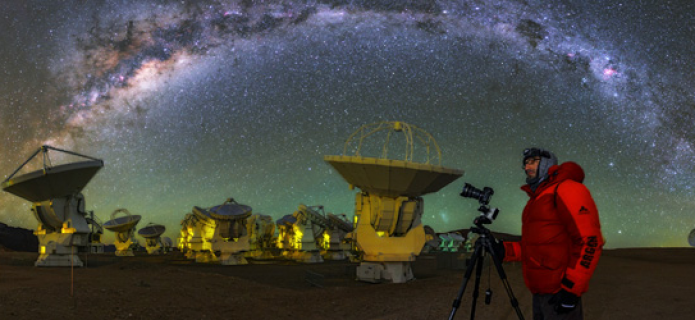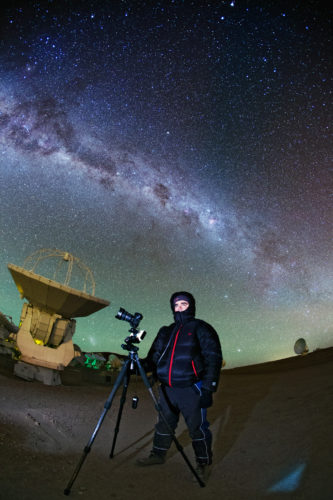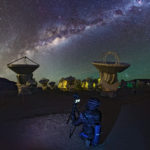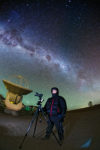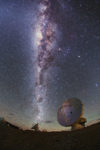First Results from the ESO Ultra HD Expedition at ALMA
12 May, 2014 / Read time: 5 minutes
The ESO Ultra HD Expedition may now be over after visiting different telescopes in Chile, including ALMA, but there is much work being done behind-the-scenes to process and combine all the footage taken — a staggering 10 TB of images and video. With four times the resolution of HD, Ultra HD takes our view of the night sky into a new, immersive dimension. The expedition team can now present some of their first results in dramatic Ultra HD footage — bringing the Universe closer than ever before.

Image 1. High on the Chajnantor Plateau, some 5000 metres above sea level it can get extremely cold at the site of the Atacama Large Millimeter/submillimeter Array (ALMA). Babak Tafreshi, one of ESO's Photo Ambassadors and part of the ESO Ultra HD Expedition team is shown here capturing the cool cosmos. Credit: ESO/B. Tafreshi
A little over a month ago, ESO’s videographer Herbert Zodet and the three ESO Photo Ambassadors: Yuri Beletsky, Christoph Malin and Babak Tafreshi embarked on their expedition to Chile with the goal of capturing footage at ESO’s observing sites in all their grandeur — using state-of-the-art Ultra HD tools [1].
Image 2. ESO Photo Ambassador, Babak Tafreshi took this photo of teammate Yuri Beletsky taking shots amongst the Atacama Large Millimeter/submillimeter Array (ALMA) during the the ESO Ultra HD Expedition. The Milky Way can be seen to stretch overhead. Credit: ESO/B. Tafreshi Image 3. High on the Chajnantor Plateau, some 5000 meters above sea level it can get extremely cold at the site of the Atacama Large Millimeter/submillimeter Array (ALMA). Yuri Beletsky, one of ESO's Photo Ambassadors and part of the ESO Ultra HD Expedition team is shown here capturing the cool cosmos. The Milky Way can be seen to stretch overhead. Credit: ESO/B. Tafreshi
First the team visited Paranal Observatory in northern Chile, home to the Very Large Telescope array (VLT). They then drove to the Atacama Large Millimeter/submillimeter Array (ALMA), the most important radio telescope of the world -financed by European, North American and Asian institutions-, located at 5000 meters above sea level, on the Chajnantor Plateau, dedicated to studying the cool Universe. Finally, the team headed to La Silla, home of a 3.6-meter telescope and the 3.58-meter New Technology Telescope [2].
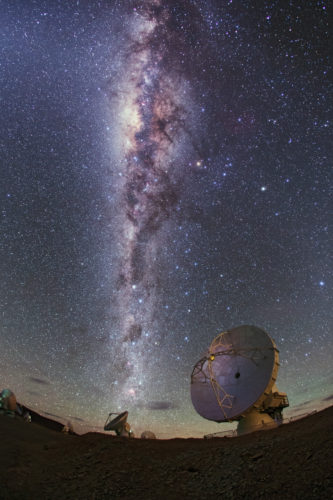
Image 4. The Milky Way glitters brightly over ALMA antennas, in this image taken by the ESO Ultra High Definition Expedition team as they capture the site in 4K quality. Credit: ESO/B. Tafreshi

Image 5. A 360 degree panorama of the Atacama Large Millimeter/submillimeter Array (ALMA), high on the Chajnantor Plateau, 5000 metres altitude in northern Chile. Taken during the ESO Ultra HD Expedition. Credit: ESO/B. Tafreshi

Image 6. Antennas of the Atacama Large Millimeter/submillimeter Array (ALMA), on the Chajnantor Plateau, 5000m above sea level are seen in this UHD panorama. The Milky Way can be seen to stretch high above with Eta Carinae Nebula, a bright emission nebula, shown giving off its fiery red glow. Taken during the ESO Ultra HD Expedition. Credit: ESO/B. Tafreshi
The team created a wide range of content including time-lapses, stills and panoramas in Ultra HD quality — as well as some material in planetarium fulldome format. The almost perfect atmospheric conditions at each of the sites provided crystal-clear views of the night sky, further enhancing this visually stunning production.

Video. The ESO Ultra HD Expedition team visit ALMA, the Atacama Large Millimeter/submillimeter Array — a huge new facility at 5000 metres above sea level on the Chajnantor Plateau, dedicated to studying the cool Universe. Captured in this day-time video compilation. The material has been edited especially for broadcast use, without commentary or music. The ESO Ultra HD Expedition was supported by the following technology partners: Canon, Kids of All Ages, Novoflex, Angelbird, Sharp, Vixen, eMotimo, Peli, Magic MultiMedia, LRTimelapse, Intecro and Granite Bay Software. Credit: ALMA (ESO/NAOJ/NRAO) Download video
Direct links for more of the first results from the expedition are here:
- For media and others:
- UHD stills, of which several are large panoramas
- UHD timelapses
- UHD day-time video footage
- For use for broadcasters the expedition is captured in a five UHD compilations featuring:
- For planetarium producers:
- UHD fulldome stills (fish-eye, 4K)
- UHD fulldome timelapses (fish-eye, 4K)
- UHD 360 degree panoramas
- Much more is in the pipeline, so stay tuned.
Notes
[1] Equipment included: Vixen Optics Polarie Star Tracker, Canon® EOS-1D C camera, Stage One Dolly and eMotimo TB3 3-axis motion control camera robot, Angelbird SSD2go, LRTimelapse software. Peli™ Cases, 4K PC workstations from Magic Multimedia, Novoflex QuadroPod system, Intecro batteries and Granite Bay Software.
[2] The full journey schedule of the expedition can be viewed here. The team shared their personal accounts of their 17-day adventure on the ESO Ultra HD Expedition blog.
More Information
You can follow the ESO Ultra HD Expedition on Twitter @ESO and under the hashtag #ESOultraHD
The ESO Ultra HD Expedition was supported by the following technology partners: Canon, Kids of All Ages, Novoflex, Angelbird, Sharp, Vixen, eMotimo, Peli, Magic Multi Media, LRTimelapse, Intecro and Granite Bay Software. Information on the expedition’s technology partners can be found here.
While the production of Ultra HD TV displays and cameras has flourished, very little Ultra HD content has been made universally available until now. ESO is now changing this by delivering free Ultra HD content to all, from consumer to broadcaster, under a very liberal licensing model.
Contact:
Valeria Foncea
Education and Public Outreach Officer
Joint ALMA Observatory
Santiago, Chile
Tel: +56 2 467 6258
Cell: +56 9 75871963
Email: [email protected]
